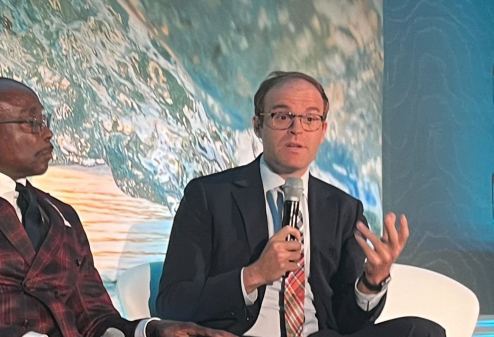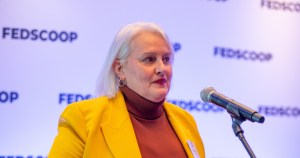 Office of Federal Procurement Policy Administrator Joseph Jordan (Photo: David Stegon/FedScoop)
Office of Federal Procurement Policy Administrator Joseph Jordan (Photo: David Stegon/FedScoop)Joseph Jordan, administrator of the Office of Federal Procurement Policy at the Office of Management and Budget, sat down with FedScoop on Thursday to discuss what his office is focused on and what to expect in the future with respect to federal government acquisition.
FedScoop: Now you are the big guy at the White House these days when it comes to procurement policy and just a few weeks ago you guys – just a couple days ago actually – you released an interesting document on past performance. Can you update everybody what that’s about?
Jordan: Absolutely, and I’m far from the big guy at the White House, except maybe in girth, but we released an updated guidance outlining agency’s responsibilities in the area of past performance.
This is a real priority for me, Dave, because we need to get the quantity of these reports up so that contracting officers have them in hand pre-award, so that they can help make good, smart decisions and engage with responsible vendors who have done a great job in the past.
We also need to improve the quality of these reports and, as an iterative step, to get towards my end-state vision, we made very clear to every agency that their responsibility now is, in a very compressed time, to get to 100 percent compliance with entering these reports in the unified government wide system.
So, that is going to be a tremendous first step, and I understand that it is hard work from the agencies, but we have to roll up our sleeves and get this done and then we’re going to work together, industry and government, to figure out how we can improve the quality of these reports.
FedScoop: What other big things do you have going on? What, maybe in the next six, 12 months are going to be main focus for you?
Jordan: Well, in the area of buying smarter and really leveraging the governments buying power, we have convened the Strategic Sourcing Leadership Council, comprised of the big seven agencies that spend about 92 percent of all federal prime contracting dollars, as well as the Small Business Administration, so that small businesses always have a seat at the table, and we’re really focused on expanding the strategic sourcing effort.
Doesn’t mean bundling, it means buying smarter, acquiring the goods and services that every agency needs in a better, more thoughtful way, improve terms and conditions, standardizing certain practices and, yes, where necessary, standing-up or doubling down on vehicles with more volume so we can drive prices and cost down. That’s a big area.
Two other areas to mention: small business contracting, this continues to be a personal passion of mine. As you know, when we met I was at SBA, I brought that desire to increase small business utilization to the job at OMB and also the fervent and firm belief that doing so, increasing our utilization of small and disadvantage business, these entrepreneurial innovative firms, is good for the taxpayer and good for the agencies, and we’ve got to continue to push there, even though we’ve got some headwinds with the budgetary uncertainties and things of that nature.
Third, and finally, I would say really pushing to develop our acquisition workforce, both in terms of a mindset shift, encouraging appropriate risk taking and innovation, entrepreneurship in our processes and the way that we acquire goods and services as well as our recruiting, and developing and retaining the contracting officers themselves.
So just today, before this event, Dan Tangherlini the administrator of GSA, and I signed an agreement to partner even more closely together on the running of the Federal Acquisition Institute, the training academy for our civilian workforce, and I’m really excited to improve both the content and the content delivery for our acquisition professionals training.
FedScoop: It’s interesting to hear you say that. I hear so much from the acquisition folks, you need to get more quality people in there, like you said in your keynote, you’re always looking for innovative ways to acquire goods and services. Could you talk about some of the things that are going on with that search, or what kinds of people, you would like them to bring to you that would help out?
Jordan: Absolutely. There’s no doubt that over time it seems like our acquisition system has become very risk-adverse, and I understand why. There’s a lot of robust oversight and that’s good, but I don’t like where that’s taken us in terms of minimizing risk instead of managing risk.
You know, if a new, data-driven, fact-based, this is the right answer, this is high expected value approach, is smart but has some risk to it, I want contracting officers to try that. I want them to be innovative, and the FAR, the contracting officer bible that has all the rules in it, says ‘you can do this.’ If we haven’t told you explicitly you cannot do something, assume you can, if it complies with sound business judgment. So, driving that mindset and cultural shift will be big, and I’m going around talking to all of our agencies on this very topic.
Secondly, we need to really increase our recruiting of these smart and talented folks into our contracting officer workforce, so that we can have a diverse set of skills and backgrounds as agencies think about how best to award contracts and get the goods and services they need to fulfill their mission.
And one other thing, really specific example of ways that we’re trying to be more innovative in bridging both that contracting officer and acquisition workforce element with the buying smarter, is something that the Small Business Administration, GSA, the White House and OMB have partnered, which is RFPEZ.
This is a way for small businesses who may not have traditionally sold to the federal government to work with this portal and get into the system to provide things like website development and innovative IT services below the simplified acquisition threshold, so below 150,000 dollars, where there are fewer rules and more flexibilities. We’re piloting this right now with agencies to really see if it’s another channel to build awareness, access these firms and get government on the cutting edge of acquiring goods and services.
FedScoop: I know small businesses, obviously you come from Small Business Administration, have a background. They tend to be some of the more innovative companies out there doing stuff, and it seems like that’s a great way to get them involved.
Jordan: Absolutely, absolutely. You know not everyone is waking up each morning, every business owner, reading the federal register, and thinking about whether their contracts are all FAR-compliant. They just know they have a kick-ass product or service offering that they absolutely are convinced that government would benefit from engaging with them on, that the taxpayer would get a better outcome if they bought this, but they don’t know how to get into the system or the system itself is so daunting they give up. We’ve got to get past that. We’ve got to take it on us, as the government, our responsibility is to reach out, find them, and bring them into our supply chain, so that the taxpayer really can win.
FedScoop: I know acquisition is such a huge, kind of all-encompassing thing when you talk to federal government. A lot of our readers really care about information technology. Can you give any insight into maybe any trends you’re seeing when it comes to IT acquisition, or any kind of things going on that you’re working on when it comes to just the IT aspect of acquisition?
Jordan: Absolutely. The acquisition of information technology is right at the top of my priority list. It’s an 80 billion dollar slice of the acquisition pie, so it is significant. Steve VanRoekel, the federal CIO, has the office right next to mine, and we talk and kick around ideas all the time and have already collaborated on a few formal efforts such as RFPEZ. Also, we issued guidance together on modular contracting.
Now, I view IT acquisition in two realms.
One is the really sophisticated, unique, maybe one-of-a-kind, first-of-a-kind, big development areas, and that’s where modular is really helpful. Not just spending 40 million dollars crossing your fingers and hoping for the best bill over the next five years, but dividing a contract and project up into measurable, incremental steps with milestones and, you know, you move in that iterative, modular, agile way.
Then there is commodity- IT, where the strategic sourcing effort fits in. Here, we’ve got to leverage our buying power, standardize terms and conditions and requirements.
We don’t need 4,000 contracts buying the same 20 laptops. We can whittle down both the administrative costs of managing all those vehicles and, on the vendor side, from bidding and doing the proposals for all those vehicles, as well as the upkeep and the maintenance of these commodity items over their lifecycle.
So, there are a number of things we’re working on and I think they’ll resonate not just with the government buyers, but with the vendors, you know, who can really share in these savings and participate in a really collaborative, partnership type of way.
FedScoop: Is there one message you would like to give to the rest of government when it comes to acquisition or industry in general that can, kind of help you do your job better, help you get the most out of what the government spends when it comes to acquisition?
Jordan: My message to agencies and our acquisition folks is one first of thanks for their dedication and public service and their significant efforts in these tough budgetary times to still fulfill their agency’s mission, find the great vendors out there, where appropriate, and buy smarter, and I’m excited to continue doubling down on some of our good efforts and partnership with them in the acquisition arena.
To the vendors I would say, I can’t repeat it often enough, I view our reform efforts as collaborative, not adversarial. This is designed to be a win-win. If we can drive costs out of the system for both the vendor, the industry partner, and the government, we really can all benefit.
We can share in those savings and, most importantly, from a government perspective, pass those along to the taxpayer, so that we still get the mission-critical goods and services our agencies need and we get them at a lower price and cost, so that we can plow those either back into mission and give them back to the taxpayer in terms of raw savings.
So, I think that we are at a really important point. I understand all the budgetary pressures that agencies and, therefore, their industry partners are facing, but let’s make sure not to waste a crisis.
Let’s use this as the burning platform so that we can increase our efforts around buying smarter, sometimes buying less, developing our acquisition workforce and building the right supplier relationships.
FedScoop: Great. For all our readers who want to follow you, you’re on Twitter now, right?
Jordan: I am! @OFPPJoe. So, I’m very excited, one of the main things when I talk about awareness building and collaboration, that doesn’t just mean putting something on the OMB website or going in and giving a talk. It means thinking about new ways I can engage with folks. You mentioned the IT community. I am deeply committed to expanding our supply chain in that area and, as you well know, you know, many of them are utilizing social media as a primary form of interaction and communication. So, I’m about three tweets in, so it’s a nascent effort, but I would love anyone that is curious and wants to stay updated on procurement policy developments to follow me at @OFPPJoe.
FedScoop: Well, you know, you only have three tweets, but I know one of them was the past performance guide…
Jordan: And that’s how you saw it!
FedScoop: That’s how I saw it.
Jordan: That’s what you said before and I’m really excited about that. That’s exactly what we’re trying to accomplish, is have folks who may not have seen some important guidance or messaging come out of our office, be able to access that, react, give us feedback and adjust. I think that’s fantastic.






